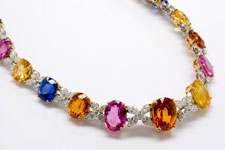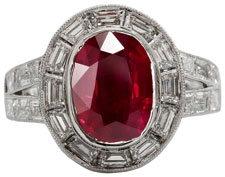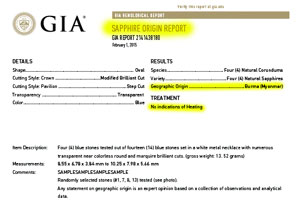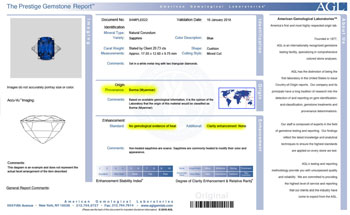Yogo sapphires – What's in a name?
 Yogo sapphire
Yogo sapphireSometimes it's: Location, location, location!
Some gems carry the name of the place they were mined, because gems in those locations are likely to have some particularly attractive qualities.
This is true of the mineral corundum, which gives us the gems sapphire and ruby.
Sapphires are corundum of any color other than red. Though usually thought of as a blue stone, sapphire can be yellow, orange, pink, green, or even colorless, depending on trace minerals. Kashmir sapphires are the most famous and fetch high prices because of their superior clarity, hue and saturation.
Yogo is not as familiar a name as Burma or Kashmir, but Yogo sapphires are the U.S.'s own, homegrown high-quality sapphires. These gems come from the Yogo Gulch in Montana.
Sapphires in Yogo Gulch were discovered in the 19th century when prospectors panning for gold found little blue pebbles in the debris. Even today, visitors to the Sapphire Mountains of Montana can sift through gravel to discover their own sapphires. Attractive sapphire can be found in a number of sapphire's colors, though they do not match the quality and value of the Yogo Gulch gems.
Most commercially available sapphires are heat-treated to enhance their color. Heat treatment can turn a pale, listless color into an attractive, highly saturated hue. About 94% of the sapphires on the market today have been heat-treated.
Yogo sapphires have a well-saturated blue color that requires no heat treatment. Their color is said to hold its brilliance in both natural and artificial light, which is also a rarity for sapphire. One estimate put the value of Yogo sapphires at $10,000 per carat, compared to about $1,000 per carat for other Montana sapphires.
Rubies—that is, red corundum—can be found in a range of reds that includes pinkish, purplish, orangey, and brownish variations. The precise coloring is determined by trace minerals in the geologic location that produced the ruby. Rubies from Burma (Myanmar) are prized for their exceptional color, which has been described (in evocative, though certainly not gemological, language) as "Pigeon's blood" or a deep red with a bluish hue.
The mine's location is not the whole story
Even when a location is known for producing superior rubies or sapphires, not all gems from the mine are of high quality and value. What the insurer—and consumer—care about is this particular gem, and that requires an appraisal.
Most jewelers and appraisers deal primarily with diamonds, but a colored gem should have an appraisal from a trained gemologist who is familiar with the market for colored gems.
Names like Burma ruby, Kashmir sapphire, and Yogo sapphire have a prestige that increases the gem's market value. If the source of the stone was said to be one of these premier locations, be sure it also has a lab report verifying the gem's origin, as well as its quality.
Appraisals for colored gems
For colored gemstones, color is the most important determinant of value. The description must be in proper gemological language, not metaphorical or poetic terms such as "cornflower" blue or "pigeon blood" red. (Gemologists joke about how to apply this traditionally used term: first you have to find a pigeon, then you have it kill it, then you have to compare the gem within the first 24 hours. . . .)
For quality ruby, even slight variations in color can mean significant differences in valuation. An experienced eye and an accurate gemological description of color will distinguish ruby from pink sapphire, which is worth considerably less.
A gemological description, giving tone, saturation, and hue, should look something like this: medium dark (tone), vivid (saturation) purplish red (hue)
A word about locations of diamond mines
Just to be clear: for diamonds, location of the mine does not signal quality.
Colored gems like ruby and sapphire develop in the earth's crust, relatively near the earth's surface. Here the gem material encounters other minerals that influence its color. Yogo sapphire, for example, owes its deep blue to traces of titanium.
Diamonds, on the other hand, were formed hundreds of millions of years ago deep in the earth's mantle and are brought to the surface by some dramatic event, such as a volcanic eruption. They are not affected by the geology of the location where they are mined.
Sometimes diamond producers may append a location to their product for marketing purposes. "Canadian diamonds," for example, tells the consumer that the gems being sold are not blood diamonds, the term for diamonds mined by forced labor, with profits going to support insurgents. Knowing the Canadian source may be important to some consumers, but the location of a diamond mine reveals nothing about the quality of the diamond.
FOR AGENTS & UNDERWRITERS
For colored stones, color is the main determinant of value. The appraisal should describe the gem's color in precise terms of tone, saturation and hue. A vague description, such as "blue sapphire," is useless.
High-value, purportedly rare, gems should always have their quality verified by a gemologist who is experienced in the buying and selling of that gem, is familiar with its pricing, and is aware of treatments and scams associated with that gem.
The best appraisal includes the JISO 78/79 appraisal form and is written by a qualified gemologist (GG, FGA+, or equivalent), preferably one who has additional insurance appraisal training. One course offering such additional training is the Certified Insurance Appraiser™ (CIA) course of the Jewelry Insurance Appraisal Institute.
Gems sold as coming from a premier source, such as Kashmir, Burma, Ceylon and Yogo rubies and sapphires, should be accompanied by a report from a reliable lab. Be sure the report is one that verifies the gem's origin, as labs may offer several reports, at different prices, containing more or less information.
These are the major trustworthy labs:
GIA
AGL
Gübelin
AGS
GCAL Certificate Search
The insured can take the jewelry to her own jeweler, who will send it to a lab that has the equipment and expertise to determine gem origin.
All treatments should be disclosed.
The vast majority of ruby and sapphire are subjected to heat treatment to improve their color. Often these gems are sold without the treatments being disclosed. Treated gems are worth considerably less than untreated gems of similar appearance.
Unheated sapphires of attractive color are extremely rare and are priced accordingly. If a gem is unheated, that should be specified on the appraisal.
Synthetic rubies and sapphires are quite common. The appraisal should state that the gem is either mined or lab-made (synthetic), since lab-made gems are worth considerably less.
FOR ADJUSTERS
Check the appraisal for words such as synthetic, lab-grown, lab-made, cultured, or manufactured. The term Lindy or Linde describes a star sapphire that is lab-made.
There is always the danger that gem treatments will not be disclosed — by the supplier, the dealer, the jewelry manufacturer, the retailer, or the consumer — either out of ignorance or as deliberate fraud. The insurer is at the end of this chain and could wind up grossly overpaying a claim.
Fracture-filled rubies are penetrating the marketplace and may be passed off as untreated gems. Check the appraisal for the terms fracture-filled, treated, and clarity-enhanced.
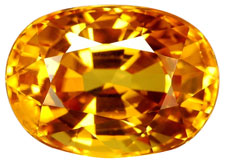 Beryllium-diffused sapphire
Beryllium-diffused sapphire sold with disclosure by GemSelect.
Ruby and sapphire are commonly subjected to heat treatment to improve their color. Since beryllium-diffused sapphires are common, look for mention of this treatment (sometimes called "bulk diffusion") on a sapphire appraisal.
Do not assume that if the appraisal doesn't mention treatments, the gem must be untreated; most likely, if treatment (or lack of it) is not mentioned, other information is incomplete as well.
See JISO 18 for its list of gems requiring special information for proper valuations. This form is a great checklist for verifying that all value elements are on the appraisal.
Always have damaged stones examined by a gemologist (who is not the selling jeweler) before settling a claim. For all colored gems, be sure to consult a jeweler who regularly deals with colored gemstones. The jeweler should be a GG or FGA+ and preferably also a Certified Insurance Appraiser™.
Whenever you encounter an unusual name or term on an appraisal, it's worth taking a second looks at the docs. And maybe doing a little research (Google is a good place to start). Brand names and special terms may give you important information about the gem's quality and value.
©2000-2025, JCRS Inland Marine Solutions, Inc. All Rights Reserved. www.jcrs.com

